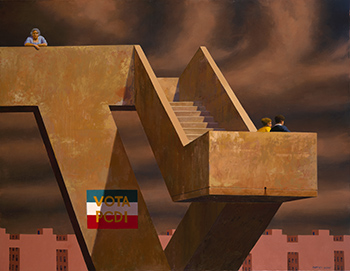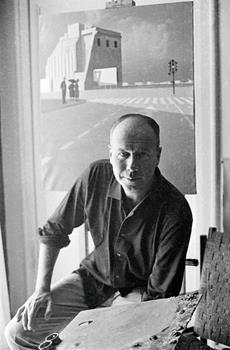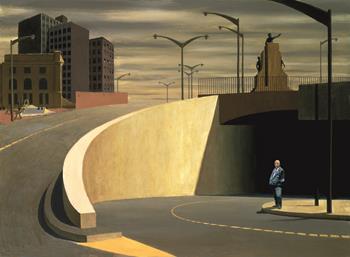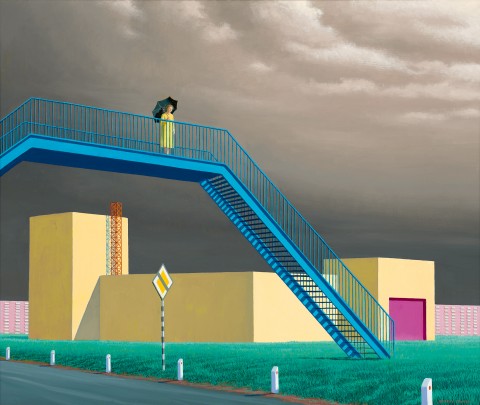THE FOOTBRIDGE, 1975
JEFFREY SMART
oil on canvas
75.5 x 90.0 cm
signed lower right: JEFFREY SMART
South Yarra Gallery, Melbourne
The National Australia Bank Art Collection, acquired from the above in 1975 (label attached verso)
Jeffrey Smart, South Yarra Gallery, Melbourne, 15 August 1975, cat. 27
The Seventies: Australian Paintings and Tapestries from the Collection of National Australia Bank, National Gallery of Victoria, Melbourne, 15 October – 28 November 1982
The Seventies: Australian Paintings and Tapestries from the Collection of National Australia Bank, Geelong Art Gallery, Victoria, 30 April - 29 May 1988
The Seventies Exhibition: Selected Paintings from the National Australia Bank Collection, MacLaurin Hall, The University of Sydney, Sydney, 6 September - 1 October 1989, cat. 32
'The Seventies' Exhibition: Selected Paintings from the National Australia Bank Collection 'Modern Art of the Seventies', Caulfield Arts Complex, Melbourne, 18 January - 11 February 1990, cat. 19
Hutchings, P., ‘Jeffrey Smart: Realism in Three Dimensions’, New Lugano Review, Switzerland, 8 – 9, 1976, pp. 60 (illus.), 115
Lindsay, R., The Seventies: Australian Paintings and Tapestries from the Collection of National Australia Bank, The National Bank of Australasia, Melbourne, 1982, pl. 83, p. 96 (illus.)
Quartermaine, P., Jeffrey Smart, Gryphon Books, Melbourne, 1983, cat. 644, p. 113
'First Public Display in Sydney of National's Paintings' The University of Sydney News, Sydney, vol. 21, no. 20, 1 August 1989, p. 170
McDonald, J., Jeffrey Smart. Paintings of the 70s and 80s, Craftsman House, Sydney, 1990, cat. 98, p. 157
Williams, D., In Our Own Image. The Story of Australian Art 1788 – 1989, McGraw Hill Book Co., New South Wales, 2nd edition, 1990, pp. 160, 161 (illus., as 'Footbridge')
Study for The Footbridge, 1974 – 75, oil on canvas, 33.0 x 45.0 cm, private collection
We are grateful to Stephen Rogers, Archivist for the Estate of Jeffrey Smart, for his assistance with this catalogue entry.
Over the Flaminia 1986.jpg

‘I find myself moved by man in this new violent environment. I want to paint this explicitly and beautifully…’1
One of the great ironies of Jeffrey Smart’s immeasurable artistic legacy is that his works should evoke the classical stillness, geometry and light of Italian Renaissance painting, only to reveal simultaneously how that humanist adventure which began five centuries ago has led to an anonymous and inhuman contemporary environment.2 Invariably featuring isolated figures in modern ‘Orwellian’ cities, dwarfed by their own monumental creations, his compositions have perhaps not surprisingly invited comparison with both the haunted empty Italian piazze of pittura metafisica exponent, Giorgio de Chirico (1888 – 1978), and the lonely vistas of urban America depicted by Edward Hopper (1882 – 1967) whose art betrayed the melancholy belief that human beings and their values were being swallowed up by the rapacious advance of industrialisation. Yet to infer that Smart is somehow censorious or despairing of this urban landscape is misguided, notwithstanding the brooding unquiet skies, impersonal architecture and solitary figures that are the hallmarks of his art – as magnificently encapsulated here in The Footbridge, 1975. Rather his response is one of inexplicable supplication or gratitude for an often modest, slightly odd visual phenomenon in the contemporary world that has inspired him to spend time in the gloriously difficult process of constructing a painting.3 As Smart reflects, ‘When I am painting a beautiful object that has haunted me, I feel I’m doing no more than paying homage to it, in very much the same way as you Christians praise your Lord.’4 Redolent with his love of ambiguity and seductive in their ‘super-realism’, Smart’s compositions thus ‘elevate mundane familiarities… to the status of semi-mystic icons’5 – encouraging his audience to see the ‘everyday’ with fresh eyes, to discern beauty in the most unprepossessing, unromantic of subjects.
210719.jpg

For Smart, the 1970s were a particularly formative decade – he had finally achieved financial security; his art was beginning to attract the widespread critical and commercial success it so deserved; and he had found lasting contentment in his personal life. Having acquired ‘Posticcia Nuova’ in 1971 – a rustic farmhouse, situated in the delightfully idyllic surrounds of the picturesque Tuscan countryside that was to be his home for the rest of his life – Smart’s paintings from these early halcyon years were universally applauded among his most compelling and ambitious to date. Such is eloquently attested by the number that swiftly entered public institutions upon their exhibition at South Yarra Gallery, Melbourne (1972) and Rudy Komon Gallery in Sydney (1973), including the celebrated Factory and Staff, Erehwyna, 1972 (National Gallery of Victoria); Truck and Trailer Approaching a City, 1973 and Bus Terminus, 1973 (both Art Gallery of New South Wales) and The Traveller, 1973 (Queensland Art Gallery / Gallery of Modern Art). By 1975, when Smart embarked upon The Footbridge, he had met his lifelong partner Ermes De Zan, who moved in with him in June the same year, and would offer a source of unwavering support and inspiration over the following four decades; as Smart reminisced, ‘…it was the beginning… of the happiest time of my life.’6 Other major works completed around this time included Central Station II, 1974 – 75 (Art Gallery of New South Wales) and Sunday Morning II, 1975 (private collection), while the closing years of the decade witnessed the emergence of such iconic compositions as The Guiding Spheres II (Homage to Cezanne), 1979 – 80 (private collection) and Autobahn in The Black Forest II, 1979 – 80 (private collection).
Frequently punctuating Smart’s vast oeuvre, the compositional motif of one or more figures atop a footbridge or overpass appears arguably most famously in works such as The Underpass, 1986 – 87 (Parliament House Art Collection, Canberra) where the viewer is positioned on a footbridge over a highway watching both a truck pass below and the figure of a solitary woman leaning over the railing of a distant, parallel footbridge, and Over The Flaminia, 1986 (private collection) where we seem to be spying on a couple on the lower platform of the footbridge, while the figure of an old lady in the top left corner of the composition stares directly at us. Although unmistakably drawing its inspiration from the eponymous structure crossing the Botany freight line on the approach to the Sydney airport terminals which Smart would have glimpsed from the car many times on his travels, The Footbridge does not offer a faithful depiction en plein air of an exact scene. Rather, Smart here presents a composite image – carefully constructed from the complex weaving of motifs, symbols and disparate elements recalled from either real-life locations or gleaned from other artworks, both his own and those painted by artists whom he admired, to achieve the consummate composition, an immaculately-balanced symphony of form, colour and light.
1116.jpg

Throughout his lifetime, Smart repeatedly and unequivocally declared his steadfast commitment to the abstract objectives of his art – ‘My only concern is putting the right shapes in the right colours in the right places, My main concern is always the geometry, the structure of the painting’7 – and indeed, in their deliberate orchestration, his paintings have often persuasively been compared to the Italian films of the 1950s and 60s by Fellini, Antonioni and Pasolini which typically feature composed shots distilled for poetic effect. Moreover, with the viewer here potentially cast as driver on the roadway below, The Footbridge also bears strong affinities with the 1970s road movies of Wim Wenders where the narrative unfolds through the windscreen of a car, with the audience invited to relate to the nomadic, unfulfilled characters who fleetingly experience happiness before being compelled to pack up and move on.8 Like such films, the experience of Smart’s paintings is both vicarious and voyeuristic, with the viewer implicated in scenes yet simultaneously removed from them. As Gary Catalano perceptively noted in his review of Smart’s work, ‘…the question of whether Smart’s figures are alienated or not is quite beside the point, for his main intention is to show that they, too, are watchers. Smart’s intentions do not end there. With a consistency that cannot be ignored, he orientates these watchers in such a way that they are made to gaze at something that we can have no knowledge of. Smart’s paintings are dramas which the viewer experiences as a sort of excluded witness.’9
Laden with a sense of intrigue and the suggestion of action existing and persisting just beyond the audience’s line of sight, Smart’s paintings thus tantalise the viewer towards a source of meaning – enticing them to write their own screenplay, to imaginatively reconstruct the narrative which contains each scene. Despite his insistence to the contrary, such instinct is only heightened by the artist’s inclusion of figures that invariably appear isolated, solitary in spirit and place, and imbued with an air of stillness. Exemplified most poignantly by the mysterious, one-armed, bald and portly ‘everyman’ who stands marooned in the celebrated Cahill Expressway, 1962 (National Gallery of Victoria), Smart’s protagonists are emotionally remote, distanced and wholly unengaged with either their surrounds or us, the viewer – symbols, according to some commentators, of modern man’s loneliness and disillusionment. Seemingly oblivious of the viewer and unperturbed by the storm that threatens above, the waiting female figure in The Footbridge is similarly enigmatic, provoking mediation upon her circumstance and purpose: What is she contemplating? Is she waiting for someone? If so, for whom? And why in this location?
210719 Cahill Expressway 1962.jpg

© The Estate of Jeffrey Smart
Like the best of Smart’s achievements, The Footbridge beguiles both the eye and mind its ambiguity, remaining infinitely suggestive but revealing nothing. Although his works have frequently been construed as bleak, Hopper-esque commentaries on a society alienated by technology or a world impoverished by mass-produced architecture, such pessimistic interpretations would seem to negate Smart’s own professed intentions for his art. For, as Barry Pearce elucidates, his paintings ‘…are, at the end of the day, expressions of himself. Container trucks which pollute cities, highways which have displaced communities, and modulised buildings which have absolved individuals from caring about each other are not in themselves beautiful. They cannot be, except that from the tranquillity of his eighteenth-century farm in Tuscany, Smart has made them beautiful by extracting time and noise and pain.’10 Relentlessly asserting his faith in the timeless beauty he perceives amidst the clutter of contemporary life, Smart’s paintings convey rather, a rich sense of optimism despite their occasional uncertainties – a poignant reminder that the things which seem upon first glance to reflect a brutality to the soul can become, ironically, a source of wonder.11 As Quartermaine ultimately reiterates, ‘…Smart’s paintings are not to be looked through but looked at. If we look through them, we find only the preconceptions we brought with us – by looking at them with the attention they demand we can experience their world.’12
1. The artist, cited in Horton, M. (ed.), Australian Painters of the ’70s, Ure Smith, Sydney, 1975, p. 54
2. Allen, C., ‘Introduction’ in Jeffrey Smart, Philip Bacon Galleries, Brisbane, 2005, p. 3
3. Pearce, B., Jeffrey Smart, Sydney, 2005, p. 193
4. The artist, cited in Hutchings, P., ‘Some contemporary realisms’, 1971, in Smith, B. (ed.), Concerning contemporary art: The Power Lectures 1968 – 1973, Clarendon Press, Oxford, 1974, pp. 124 – 25
5. Capon, E., ‘Still, Silent, Composed: The Art of Jeffrey Smart' in Jeffrey Smart, Art Gallery of New South Wales, Sydney, 1999, p. 16
6. ‘Jeffrey Smart’s partner Ermes de Zan recalls artist’s life in Tuscany’, The Australian, 21 May 2016
7. The artist, cited in McGrath, S., ‘Jeffrey Smart’, Art & Australia, vo. 7, no. 1, June, 1969, p. 34
8. McDonald, P., Jeffrey Smart, Gryphon Books, Melbourne, 1983, p. 78
9. ‘The Art of being a Good Detective', The Age, 10 May 1989, p. 14
10. Pearce, B, ‘Out of Adelaide’ in Jeffrey Smart, 1999, op. cit., p.32
11. Ibid.
12. Quartermaine, P., Jeffrey Smart, Gryphon Books, Melbourne, 1983, p. 78
VERONICA ANGELATOS
